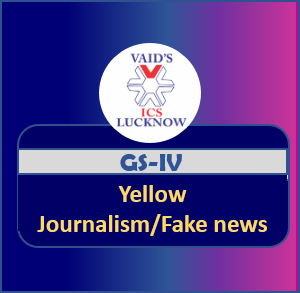CURRENT AFFAIRS
Get the most updated and recent current affair content on Padhaikaro.com
Yellow Journalism/Fake News
- Vaid's ICS, Lucknow
- 27, Jul 2021

Why in News?
Stakeholders are attempting to find a robust and effective solution to deal with Fake news and its associated social problems.
About
- The Indian government has been attempting to bring in several legal amendments to deal with fake news, its creation, propagation and effects.
- Social media companies are also investing billions of dollars into technological solutions such as Artificial Intelligence (AI) to identify fake news and its proliferation.
About Fake News (Yellow Journalism)
- Fake news or hoax news refer to false propaganda published under the guise of authentic news.
- It is deliberately created to misinform the readers.
- Fake news can be propagated through any media: print, electronic and social.
- Fake news can be related to anything –
- Commercially driven sensational content
- Nation-state sponsored misinformation
- Highly partisan news site
- Social media itself
- Satire or parody
- Some checks and balances exist in the mainstream media against fake news, but social media does not have such a mechanism.
Effects of Fake News
- With millions of people using social media in a country like India, fake news is no less than a potential disaster.
- It can be used to influence public opinions, to gain popularity or to malign the image, character of certain individuals or opponents or to defame them.
- It polarizes public opinion and affects political institutions, political disinformation campaigns in the Indian electoral system could lead to the deepening of existing social discord, loss of civic trust in the electoral system, and the compromise of basic democratic principles.
- It affects social & communal harmony by spreading extremists’ ideologies especially in sensitive areas like radicalization of youths, inciting violence and hatred among the communities, swinging public opinions etc.
Challenges in controlling the Fake News
- No standard definition: The term ‘fake news’ is vague and there is no official definition of what constitutes fake news.
- Lack of regulation: Self-regulation by mainstream media has largely been ineffective.
- Any direct effort by the government to control fake news is prone to be seen as an assault on the freedom of media which functions as the fourth pillar of democracy.
- Difficult to achieve balance: The efforts to control fake news should not threaten to cramp legitimate investigative and source-based journalism or freedom of expression as guaranteed in Article 19 of the Constitution.
- Also, distinguishing between the conscious fabrication of news reports and news reports put out in the belief that they are accurate.
- Tracking fake news on social media: The vastness of the internet users (over 35 crores in India) and social media users (over 20 crore WhatsApp users alone) makes tracing the origin of fake news almost impossible.
Legal remedies available to tackle this menace:
- Indian Broadcast Foundation (IBF): This body was created in 1999 to look into the complaints against content aired by 24×7 channels.
- The Press Council of India: It is created by an Act of Parliament, is a statutory body and keeps vigil on fake news. It can warn, admonish or censure the newspaper, the news agency.
- IPC Sections 153A and 295: Under this action can be initiated against someone creating or spreading fake news if it can be termed as hate speech.
- Broadcasting Content Complaint Council (BCCC): A complaint relating to objectionable TV content or fake news can be filed to the Broadcasting Content Complaints Council.
- Defamation Suit: IPC Section 499 makes defamation a criminal offence. Section 500 provides for punishment for criminal defamation.
- The Information Technology (IT) Act: It imposes an obligation on intermediaries such as search engine giant Google to remove any objectionable content pursuant to takedown notices by law enforcement agencies.
- Contempt of Court laws: False stories about judicial proceedings would be covered by contempt of court laws and false stories about Parliament and other legislative bodies would violate privilege.
- The Constitution of India provides a long-term solution under Article 51A (h), which says, “It shall be the duty of every citizen to develop the scientific temper, humanism and the spirit of inquiry and reform.
Facts for Prelims:
SMILE (Support for Marginalized Individuals for Livelihood and Enterprise) Scheme:
- It is formulated by the Ministry of Social Justice and Empowerment which includes a subscheme – ‘Central Sector Scheme for Comprehensive Rehabilitation of persons engaged in the act of Begging’.
Key Points
- The scheme covers several comprehensive measures including welfare measures for persons who are engaged in the act of begging.
- The focus of the scheme is extensively on rehabilitation, provision of medical facilities, counseling, basic documentation, education, skill development, economic linkages and so on.
- The scheme would be implemented with the support of State/UT Governments/Local Urban Bodies, Voluntary Organizations, Community Based Organizations (CBOs) , institutions and others.